
|
Great outburst occured on Oct. 24, and it bacame a naked eye comet of 2 mag. It still keeps so bright as 4.2 mag on Feb. 22 (Juan Jose Gonzalez). It will be visible with naked eyes for a while in the dark sky. However, it became hard to see and reported so faint as 5-6 mag without an excellent sky condition. It was completely stellar just after the outburst. Then the coma had spread out and now it looks like a huge nebula. The coma diameter has increased up to about 90 arcmin in December and January. But now it is going away from the earth, and the diameter reduced to about 60 arcmin. It will be getting lower gradually in the evening sky after this. The altitude will be lower than 30 degrees in late April.
Date(TT) R.A. (2000) Decl. Delta r Elong. m1 Best Time(A, h)
Mar. 1 3 50.44 37 60.0 2.922 2.976 83 4.7 19:19 (106, 65)
Mar. 8 4 0.11 37 39.9 3.043 3.006 78 4.8 19:25 (106, 60)
|
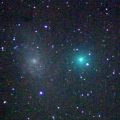
|
It passed near by Earth in early January, and it became a bright large object at 5.4 mag (Jan. 3, Seiichi Yoshida). It was visible with naked eyes. Now it is fading. But the fading is slower than originally predicted, and it is still bright as 7.4 mag (Feb. 26, Marco Goiato). It has already moved away towards the southern sky, and it is no longer observable in the Northern Hemisphere. In the Southern Hemisphere, it keeps observable until it fades out.
Date(TT) R.A. (2000) Decl. Delta r Elong. m1 Best Time(A, h)
Mar. 1 3 35.70 -54 8.9 0.934 1.149 73 7.5 19:19 ( 20, -4)
Mar. 8 3 48.58 -55 49.3 1.000 1.199 74 7.8 19:25 ( 22, -7)
|

|
Now it reached to the maximum brightness at 8.3 mag (Feb. 6, Juan Jose Gonzalez). It keeps observable at 8.5 mag in good condition until March. In the Northern Hemisphere, it keeps observable in good condition until July when it becomes fainter than 18 mag.
Date(TT) R.A. (2000) Decl. Delta r Elong. m1 Best Time(A, h)
Mar. 1 3 9.97 24 23.4 0.932 1.120 71 8.7 19:19 ( 85, 53)
Mar. 8 3 44.62 27 58.9 0.954 1.154 72 9.0 19:25 ( 91, 55)
|
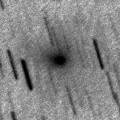
|
It brightened up to 8.5 mag on Jan. 6 (Alexandre Amorim). Now it is fading gradually, but still bright as 10.2 mag (Feb. 26, Marco Goiato). It is observable in good condition in the Southern Hemisphere. It is also appearing in the evening sky in the Northern Hemisphere. It keeps observable while fading gradually until May.
Date(TT) R.A. (2000) Decl. Delta r Elong. m1 Best Time(A, h)
Mar. 1 5 56.31 -41 11.3 1.171 1.629 97 10.8 19:19 ( 0, 14)
Mar. 8 5 58.92 -31 18.2 1.285 1.715 96 11.3 19:25 ( 7, 24)
|

|
Now it is bright as 12.1 mag (Feb. 7, Stuart Rae). It will reach to 11 mag in spring. It will keep bright for a long time, however, it keeps moving in the southern sky for a while after this. In the Northern Hemisphere, it keeps extremely low and hard to observe for a while. However, it will be getting higher after March, and will be visible visually at 11 mag in the evening sky until June. Then it becomes unobservable again. But it will appear in the morning sky again at 13 mag at the end of 2008, then it keeps bright and observable for a while.
Date(TT) R.A. (2000) Decl. Delta r Elong. m1 Best Time(A, h)
Mar. 1 9 30.64 -48 9.5 2.407 3.046 121 11.5 22:51 ( 0, 7)
Mar. 8 9 27.83 -46 25.6 2.353 3.017 123 11.5 22:21 ( 0, 9)
|

|
The return of a comet discovered in 2003 by SOHO spacecraft. It can be a short periodic comet with a period of about 4 years. If so, it is expected to return in 2008 spring. If it passes the perihelion in spring, it will be visible at 12-15 mag in the evening sky. But the period is quite uncertain with an error of several months. So we have to wait until it is re-discovered by chance.
Date(TT) R.A. (2000) Decl. Delta r Elong. m1 Best Time(A, h)
Mar. 1 0 24.46 -3 20.5 1.164 0.483 24 11.6 19:19 ( 83, 4)
Mar. 8 1 17.11 0 29.1 1.062 0.554 31 12.3 19:25 ( 83, 11)
|
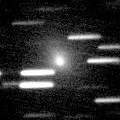
|
New bright comet discovered by two Chinese amateurs. It is very bright visually at 12.2 mag (Feb. 6, Juan Jose Gonzalez). It keeps 12 mag until May. In the Northern Hemisphere, it keeps observable in good condition in the evening sky until mid May. But then it moves southwards, and it will never be observable again. In the Southern Hemisphere, it appears in late March, then it keeps observable until it fades out.
Date(TT) R.A. (2000) Decl. Delta r Elong. m1 Best Time(A, h)
Mar. 1 2 14.02 55 41.1 1.320 1.448 76 12.2 19:19 (137, 48)
Mar. 8 2 57.05 51 52.2 1.304 1.400 73 12.0 19:25 (131, 49)
|

|
Now it is 16.8 mag (Feb. 13, Katsumi Yoshimoto). Now it is brightening rapidly. However, it is fainter than this ephemeris by 1.5 mag so far. It is expected to reach to 13 mag in March and April, and to be visible visually. But actually, it may be fainter than expected. It keeps observable in good condition for a long time in the Southern Hemisphere. In the Northern Hemisphre, it keeps locating low until March. But it will be getting higher after April and observable while the comet is fading.
Date(TT) R.A. (2000) Decl. Delta r Elong. m1 Best Time(A, h)
Mar. 1 16 28.45 -37 45.1 0.604 1.154 89 13.4 5:05 (350, 16)
Mar. 8 17 9.56 -33 58.8 0.580 1.135 88 13.0 4:56 (345, 19)
|
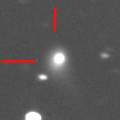
|
It brightened up to 13.5 mag and became visible visually in 2007 autumn (Nov. 13, Juan Jose Gonzalez). It will reach to 10.5 mag and will be observable in good condition in 2008 autumn. Now it is not observable. But it will appear in the morning sky at 12.5 mag in May, then it keeps observable, visible visually, brighter than 14 mag for one year until 2009 May.
Date(TT) R.A. (2000) Decl. Delta r Elong. m1 Best Time(A, h)
Mar. 1 22 55.77 7 26.2 4.180 3.234 15 13.2 19:19 (105, -8)
Mar. 8 23 5.05 8 51.5 4.141 3.187 13 13.1 4:56 (253, -8)
|
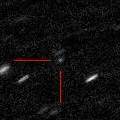
|
Now it is bright as 14.3 mag, already visible visually (Feb. 7, Juan Jose Gonzalez). It will pass 0.85 A.U. from the sun in late June, and it is expected to reach to 6 mag. In the Northern Hemipshere, it keeps observable in good condition for a long time after this, while the comet is brightening gradually. It is observable until around May 25, when the comet will be 7.5 mag. It will be unobservable for one and a half month around the perihelion passage. But it will appear in the morning sky again at 7 mag in early July, then it keeps observable after that while the comet is fading gradually. In the Southern Hemipsphere, it keeps observable all the period until the comet fades out, although it will be low in mid June.
Date(TT) R.A. (2000) Decl. Delta r Elong. m1 Best Time(A, h)
Mar. 1 12 46.23 -13 1.6 1.207 2.093 144 13.6 2:11 ( 0, 42)
Mar. 8 12 43.14 -13 59.0 1.075 2.002 151 13.2 1:40 ( 0, 41)
|
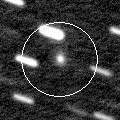
|
It is already visible visually at 14.0 mag (Jan. 12, Alan Hale). It is expected to be 7 mag in September. But it keeps moving in the southern sky, so it is difficult to see in the Northern Hemisphere. It will be locating in the very low sky at about 10 degree high until mid March, then it becomes unobservable in the Northern Hemisphere. It will appear in the evening sky at 7 mag in late September, but it keeps locating in the evening low sky until the end of 2008 when it fades out down to 10 mag. Then it turns to appear in the morning sky, and it keeps observable in the northern sky after that while fading gradually. In the Southern Hemisphere, it keeps observable until late October after this.
Date(TT) R.A. (2000) Decl. Delta r Elong. m1 Best Time(A, h)
Mar. 1 5 22.83 -41 55.9 3.004 3.183 91 13.4 19:19 ( 7, 13)
Mar. 8 5 17.83 -40 58.8 2.988 3.105 87 13.3 19:25 ( 14, 12)
|

|
After an outburst on Dec. 29, some outbursts occured repeatedly until mid January. It became very bright as 10.4 mag on Jan. 15 (P. Clay Sherrod). Then it is fading gradually. But it is still bright as 11.5 mag on Feb. 7 (Juan Jose Gonzalez).
Date(TT) R.A. (2000) Decl. Delta r Elong. m1 Best Time(A, h)
Mar. 1 5 47.67 29 20.7 5.642 6.000 106 13.6 19:19 ( 20, 84)
Mar. 8 5 48.56 29 10.3 5.753 6.002 99 13.6 19:25 ( 60, 79)
|

|
Now it is 14.1 mag, already visible visually (Feb. 8, Alan Hale). It will reach to 13.5 mag from March to July. It keeps observable in good condition for a long time until May.
Date(TT) R.A. (2000) Decl. Delta r Elong. m1 Best Time(A, h)
Mar. 1 12 44.55 6 25.0 2.524 3.426 151 14.1 2:09 ( 0, 61)
Mar. 8 12 40.78 6 4.1 2.450 3.393 158 14.0 1:38 ( 0, 61)
|
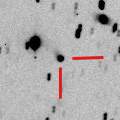
|
Now it is 15.2 mag (Jan. 25, Ken-ichi Kadota). It will be bright at 12 mag for a long time from 2008 spring to 2009 spring. However, it is only observable until August in the Northern Hemisphere because the comet moves southwards. It keeps observable for a long time in the Southern Hemisphere.
Date(TT) R.A. (2000) Decl. Delta r Elong. m1 Best Time(A, h)
Mar. 1 18 13.23 -3 5.1 3.998 3.752 68 14.3 5:05 (309, 38)
Mar. 8 18 16.18 -3 36.1 3.846 3.705 74 14.1 4:56 (313, 40)
|

|
It will reach to 11 mag in summer. It must have already brightened up to 15 mag, but the comet was not observed recently. The condition in this apparition is bad. In the Southern Hemisphere, it keeps extremely low, or under the horizon, so it will not be observable. In the Northern Hemisphere, it is not observable until August when it appears in the morning sky at 11 mag. After August, it keeps observable and fading in the morning sky.
Date(TT) R.A. (2000) Decl. Delta r Elong. m1 Best Time(A, h)
Mar. 1 23 33.32 -25 24.4 2.958 2.062 20 14.5 19:19 ( 72,-19)
Mar. 8 23 49.14 -23 29.9 2.912 2.011 20 14.3 19:25 ( 76,-21)
|

|
It was 15 mag on Jan. 14 (Michael Mattiazzo), brightening as expected. It will reach to 13.5 mag in the southern sky in spring and summer. In the Southern Hemisphere, it keeps observable for a long time after this. But in the Northern Hemisphere, it is already unobservable. It will be observable again at the end of 2008, when the comet will already fade down to 15 mag.
Date(TT) R.A. (2000) Decl. Delta r Elong. m1 Best Time(A, h)
Mar. 1 1 29.73 -44 55.7 3.217 2.707 51 14.4 19:19 ( 41,-10)
Mar. 8 1 43.04 -44 42.9 3.184 2.679 51 14.3 19:25 ( 44,-13)
|
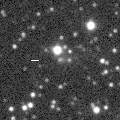
|
Now it is bright as 13.4 mag and visible visually (Jan. 4, Seiichi Yoshida). It will keep visible visually at 14 mag until March.
Date(TT) R.A. (2000) Decl. Delta r Elong. m1 Best Time(A, h)
Mar. 1 7 38.54 14 51.6 1.995 2.766 132 14.4 21:00 ( 0, 70)
Mar. 8 7 40.74 14 34.1 2.082 2.790 126 14.5 20:35 ( 0, 70)
|

|
Appearing in the morning sky. It shoudl be already bright as 15 mag. It will be getting higher gradually after this, and will be observable at 14 mag in good condition from spring to summer. It will also be visible visually.
Date(TT) R.A. (2000) Decl. Delta r Elong. m1 Best Time(A, h)
Mar. 1 19 6.61 -22 37.5 2.545 2.143 55 14.8 5:05 (312, 15)
Mar. 8 19 23.62 -21 22.1 2.467 2.120 58 14.7 4:56 (311, 16)
|
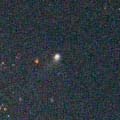
|
It was visible visually at 14 mag from spring to autumn in 2007. Now it is 13.8 mag (Feb. 13, Alan Hale). It keeps observable visually at 14 mag at high location for a while.
Date(TT) R.A. (2000) Decl. Delta r Elong. m1 Best Time(A, h)
Mar. 1 17 13.34 7 50.9 5.602 5.603 84 14.8 5:05 (317, 56)
Mar. 8 17 11.53 8 57.6 5.491 5.606 91 14.8 4:56 (324, 59)
|

|
Peculiar asteroid moving on a cometary orbit. Now it is brightest at 15.2 mag (Feb. 11, Alan Hale). It has passed the perihelion in late January, but still completely asteroidal. It keeps 15 mag until March. In the Northern Hemisphere, it keeps observable until July when it becomes fainter than 18 mag. Although already going away from the sun, it may show a cometary activity after this.
Date(TT) R.A. (2000) Decl. Delta r Elong. m1 Best Time(A, h)
Mar. 1 10 17.27 -22 18.4 0.907 1.830 149 15.0 23:38 ( 0, 33)
Mar. 8 10 18.64 -18 47.7 0.910 1.848 152 14.9 23:12 ( 0, 36)
|

|
Now it is bright as 13.4 mag and visible visually (Jan. 4, Seiichi Yoshida). It has already passed the perihelion. But it tends to be brightest after the perihelion passage. However, it will be fading after this. It is observable until April when it becomes too low at 17 mag.
Date(TT) R.A. (2000) Decl. Delta r Elong. m1 Best Time(A, h)
Mar. 1 1 45.01 11 40.2 2.224 1.724 47 15.1 19:19 ( 84, 29)
Mar. 8 2 2.01 14 26.3 2.312 1.769 45 15.3 19:25 ( 89, 27)
|
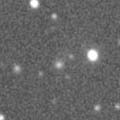
|
It was observed at 16 mag in 2007 spring and summer. In the Southern Hemisphere, it keeps 15-16 mag and observable in good condition until summer. In the Northern Hemisphere, it will never be observable again. No observations have been reported recently, and the current brightness is uncertain.
Date(TT) R.A. (2000) Decl. Delta r Elong. m1 Best Time(A, h)
Mar. 1 18 58.99 -50 5.5 3.151 2.853 63 15.2 5:05 (331, -6)
Mar. 8 19 14.91 -50 10.0 3.111 2.879 67 15.3 4:56 (331, -5)
|

|
It reached to 12.7 mag on Dec. 4 (Juan Jose Gonzalez). It keeps locating in good position for a while after this. But it is already fading slowly. But it is still bright and visible visually at 13.3 mag (Jan. 4, Seiichi Yoshida).
Date(TT) R.A. (2000) Decl. Delta r Elong. m1 Best Time(A, h)
Mar. 1 3 49.16 32 21.3 1.731 1.866 81 15.3 19:19 ( 93, 64)
Mar. 8 4 8.58 32 28.6 1.818 1.895 78 15.5 19:25 ( 95, 61)
|

|
It is already bright as 14.3 mag and visible visually (Dec. 9, Seiichi Yoshida). It is expected to reach to 11 mag in 2009 summer. Because it moves in the northern sky, it keeps observable until it becomes brightest in the Northern Hemisphere.
Date(TT) R.A. (2000) Decl. Delta r Elong. m1 Best Time(A, h)
Mar. 1 3 10.73 58 9.3 5.489 5.475 83 15.3 19:19 (143, 54)
Mar. 8 3 9.57 57 35.0 5.544 5.427 78 15.3 19:25 (140, 50)
|
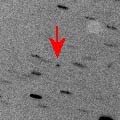
|
Now it is 14.5 mag and visible visually (Jan. 4, Seiichi Yoshida). It will be observable at 14.5-15 mag in an excellent condition until February. It starts fading after March, and will be too low at 17 mag in June.
Date(TT) R.A. (2000) Decl. Delta r Elong. m1 Best Time(A, h)
Mar. 1 5 16.90 24 9.5 2.130 2.494 99 15.7 19:19 ( 41, 76)
Mar. 8 5 24.37 23 46.6 2.220 2.497 94 15.8 19:25 ( 56, 72)
|

|
Now it is 16.4 mag (Feb. 7, J. R. Vidal), brightened as expected. It will reach to 16 mag from February to April, and will be observable in good condition.
Date(TT) R.A. (2000) Decl. Delta r Elong. m1 Best Time(A, h)
Mar. 1 10 0.93 55 52.0 0.747 1.583 130 16.2 23:20 (180, 69)
Mar. 8 9 43.69 52 6.0 0.728 1.558 129 16.1 22:36 (180, 73)
|

|
Now it is 16.6 mag (Jan. 19, Ken-ichi Kadota), brightening as expected. It keeps observable at 16.5 mag in good condition until April.
Date(TT) R.A. (2000) Decl. Delta r Elong. m1 Best Time(A, h)
Mar. 1 12 43.39 5 21.3 1.406 2.325 151 16.4 2:08 ( 0, 60)
Mar. 8 12 39.67 6 9.9 1.398 2.352 158 16.5 1:37 ( 0, 61)
|

|
It keeps 16 mag for one year from 2008 spring to 2009 spring. In the Northern Hemisphere, it keeps observable in good condition while the comet is brightening until 2008 spring. But the comet moves southwards after that, and it will never observable after 2008 July.
Date(TT) R.A. (2000) Decl. Delta r Elong. m1 Best Time(A, h)
Mar. 1 12 21.44 12 8.8 3.426 4.353 156 16.6 1:46 ( 0, 67)
Mar. 8 12 13.09 11 52.2 3.356 4.318 163 16.5 1:10 ( 0, 67)
|

|
Now it is 17.3 mag (Jan. 26, J. Manteca, A. Sanchez). It is brighter than originally expected by 1 mag. It will be observable at 15.5-16 mag from April to July. It will be fainter than 18 mag in late August. It keeps locating in the evening sky all time.
Date(TT) R.A. (2000) Decl. Delta r Elong. m1 Best Time(A, h)
Mar. 1 6 51.37 22 19.1 0.836 1.593 121 16.6 20:13 ( 0, 77)
Mar. 8 6 52.67 21 57.3 0.844 1.547 114 16.5 19:47 ( 0, 77)
|

|
Now it is 16.7 mag (Feb. 7, J. R. Vidal), brightened as expected. It will be observable in good condition for a hile until spring. It will reach to 16.5 mag in March.
Date(TT) R.A. (2000) Decl. Delta r Elong. m1 Best Time(A, h)
Mar. 1 10 45.80 35 23.3 1.613 2.532 152 16.6 0:11 (180, 90)
Mar. 8 10 40.76 35 53.2 1.625 2.523 148 16.6 23:34 (180, 89)
|

|
It will reach to 15 mag in 2009 and 2010. Now it is 16.5 mag (Dec. 18, J. R. Vidal). It will be observable at 16.5 mag in good condition until March.
Date(TT) R.A. (2000) Decl. Delta r Elong. m1 Best Time(A, h)
Mar. 1 4 50.54 23 53.9 3.752 3.938 93 16.8 19:19 ( 57, 72)
Mar. 8 4 54.09 24 3.5 3.849 3.930 87 16.8 19:25 ( 69, 66)
|
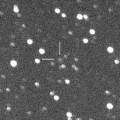
|
Now it is 16.6 mag (Jan. 19, Ken-ichi Kadota). It will reach to 15.5 mag in autumn and will be observable in good condition. In this winter, it is observable at 17 mag in good condition until March.
Date(TT) R.A. (2000) Decl. Delta r Elong. m1 Best Time(A, h)
Mar. 1 4 22.57 9 12.8 3.600 3.647 84 16.9 19:19 ( 46, 56)
Mar. 8 4 17.87 9 54.9 3.714 3.621 76 16.9 19:25 ( 59, 51)
|

|
It will reach to 13 mag in 2010. Now it is around the aphelion, but it is observable at 17 mag in good condition.
Date(TT) R.A. (2000) Decl. Delta r Elong. m1 Best Time(A, h)
Mar. 1 8 15.57 31 10.6 3.407 4.189 137 16.9 21:37 ( 0, 86)
Mar. 8 8 12.49 31 9.9 3.468 4.174 129 16.9 21:06 ( 0, 86)
|

|
It was visible visually at 14.6 mag on Jan. 4 (Seiichi Yoshida). But it is already fading. It keeps observable in good condition for a while, but it will be fainter than 18 mag in April.
Date(TT) R.A. (2000) Decl. Delta r Elong. m1 Best Time(A, h)
Mar. 1 4 1.89 41 40.2 2.026 2.199 86 17.0 19:19 (115, 67)
Mar. 8 4 18.21 41 22.8 2.124 2.228 82 17.2 19:25 (114, 64)
|

|
It will be observable at 17.5 mag in good condition until May.
Date(TT) R.A. (2000) Decl. Delta r Elong. m1 Best Time(A, h)
Mar. 1 7 59.09 38 36.0 3.390 4.107 130 17.3 21:20 (180, 86)
Mar. 8 7 57.53 39 12.4 3.461 4.098 123 17.3 20:51 (180, 86)
|
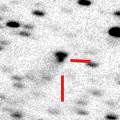
|
It was observed at 16.5-17 mag in 2006 and 2007. Because it is a very distant comet, it is observable at 17 mag still in 2008 in good condition.
Date(TT) R.A. (2000) Decl. Delta r Elong. m1 Best Time(A, h)
Mar. 1 19 44.87 24 15.0 6.581 6.066 54 17.4 5:05 (264, 37)
Mar. 8 19 46.31 25 23.6 6.532 6.079 58 17.4 4:56 (265, 41)
|

|
It had been observed at 16.5 mag for a long time from 2005 to 2007. Now it is fading. But it keeps observable at 17.5 mag in good condition for a long time until July.
Date(TT) R.A. (2000) Decl. Delta r Elong. m1 Best Time(A, h)
Mar. 1 14 34.54 15 55.7 7.716 8.314 124 17.5 3:59 ( 0, 71)
Mar. 8 14 32.50 16 3.4 7.663 8.338 130 17.5 3:29 ( 0, 71)
|

|
Now it is 17.7 mag (Dec. 15, Ken-ichi Kadota). Because it is a very distant comet, it keeps observable at 17.5-18 mag until 2009.
Date(TT) R.A. (2000) Decl. Delta r Elong. m1 Best Time(A, h)
Mar. 1 11 5.16 0 47.1 7.935 8.918 172 17.5 0:30 ( 0, 56)
Mar. 8 11 3.48 1 15.0 7.935 8.924 175 17.5 0:01 ( 0, 56)
|

|
It will be observable at 17.5-18 mag until March.
Date(TT) R.A. (2000) Decl. Delta r Elong. m1 Best Time(A, h)
Mar. 1 8 23.42 10 12.1 2.492 3.345 144 17.5 21:44 ( 0, 65)
Mar. 8 8 14.27 13 1.0 2.568 3.342 134 17.6 21:07 ( 0, 68)
|

|
Although it has been observable at 17 mag in good condition for a long time, it will be fainter than 18 mag in March.
Date(TT) R.A. (2000) Decl. Delta r Elong. m1 Best Time(A, h)
Mar. 1 8 54.20 37 36.4 1.868 2.706 140 17.7 22:15 (180, 87)
Mar. 8 8 52.16 37 49.1 1.953 2.735 133 17.8 21:46 (180, 87)
|
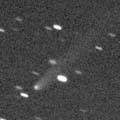
|
It was observed visually as bright as 13 mag from late 2005 to early 2006. It has already faded down to 17.6 mag (Jan. 9, M. Reszelski). It will be fainter than 18 mag soon.
Date(TT) R.A. (2000) Decl. Delta r Elong. m1 Best Time(A, h)
Mar. 1 14 27.34 -0 49.8 6.626 7.238 124 17.9 3:51 ( 0, 54)
Mar. 8 14 26.16 -0 47.4 6.572 7.272 131 17.9 3:23 ( 0, 54)
|

|
It was observed bright at 16.5-17 mag from late 2006 to early 2007. However, it is fading after that, although it is getting closer to the sun. Now it is observable in good condition, but very faint at 18.3 mag (Jan. 27, Ken-ichi Kadota). This comet was observed so faint around the perihelion passage in the previous apparition at the discovery. It faded out before the perihelion passage again in this apparition.
Date(TT) R.A. (2000) Decl. Delta r Elong. m1 Best Time(A, h)
Mar. 1 7 26.36 28 37.1 3.545 4.228 128 19.1 20:48 ( 0, 84)
Mar. 8 7 25.77 28 45.6 3.629 4.226 120 19.2 20:20 ( 0, 84)
|

|
Now it is 17.3 mag (Jan. 5, Ken-ichi Kadota). In the previous apparition in 1997, it brightened after the perihelion passage, and observed visually at 13 mag. However, such a brightening did not happen and the comet kept faint in the current apparition. However, now it may be slightly brighter than this ephemeris.
Date(TT) R.A. (2000) Decl. Delta r Elong. m1 Best Time(A, h)
Mar. 1 6 49.25 17 39.4 2.760 3.378 120 19.5 20:11 ( 0, 73)
Mar. 8 6 50.57 17 46.9 2.862 3.393 114 19.6 19:45 ( 0, 73)
|
|
![]()
 C/2003 T12 ( SOHO )
C/2003 T12 ( SOHO ) C/2008 C1 ( Chen-Gao )
C/2008 C1 ( Chen-Gao ) 26P/Grigg-Skjellerup
26P/Grigg-Skjellerup C/2006 OF2 ( Broughton )
C/2006 OF2 ( Broughton ) C/2007 W1 ( Boattini )
C/2007 W1 ( Boattini ) C/2008 A1 ( McNaught )
C/2008 A1 ( McNaught ) 29P/Schwassmann-Wachmann 1
29P/Schwassmann-Wachmann 1 C/2007 B2 ( Skiff )
C/2007 B2 ( Skiff ) C/2007 G1 ( LINEAR )
C/2007 G1 ( LINEAR ) 19P/Borrelly
19P/Borrelly C/2006 U6 ( Spacewatch )
C/2006 U6 ( Spacewatch ) C/2006 S5 ( Hill )
C/2006 S5 ( Hill ) C/2007 K3 ( Siding Spring )
C/2007 K3 ( Siding Spring ) C/2005 L3 ( McNaught )
C/2005 L3 ( McNaught ) 2005 WY3
2005 WY3 192P/2007 T3 ( Shoemaker-Levy 1 )
192P/2007 T3 ( Shoemaker-Levy 1 ) C/2006 V1 ( Catalina )
C/2006 V1 ( Catalina ) 93P/Lovas 1
93P/Lovas 1 C/2006 W3 ( Christensen )
C/2006 W3 ( Christensen ) 110P/Hartley 3
110P/Hartley 3 124P/Mrkos
124P/Mrkos 70P/Kojima
70P/Kojima C/2007 M2 ( Catalina )
C/2007 M2 ( Catalina ) 79P/du Toit-Hartley
79P/du Toit-Hartley 180P/2006 U3 ( NEAT )
180P/2006 U3 ( NEAT ) 74P/Smirnova-Chernykh
74P/Smirnova-Chernykh C/2007 U1 ( LINEAR )
C/2007 U1 ( LINEAR ) 65P/Gunn
65P/Gunn 50P/Arend
50P/Arend C/2007 T5 ( Gibbs )
C/2007 T5 ( Gibbs ) C/2005 S4 ( McNaught )
C/2005 S4 ( McNaught ) C/2002 VQ94 ( LINEAR )
C/2002 VQ94 ( LINEAR ) C/2007 D1 ( LINEAR )
C/2007 D1 ( LINEAR ) C/2007 Y1 ( LINEAR )
C/2007 Y1 ( LINEAR ) P/2007 T6 ( Catalina )
P/2007 T6 ( Catalina ) C/2003 WT42 ( LINEAR )
C/2003 WT42 ( LINEAR ) 173P/2005 T1 ( Mueller 5 )
173P/2005 T1 ( Mueller 5 ) 128P/Shoemaker-Holt 1
128P/Shoemaker-Holt 1![]()
























